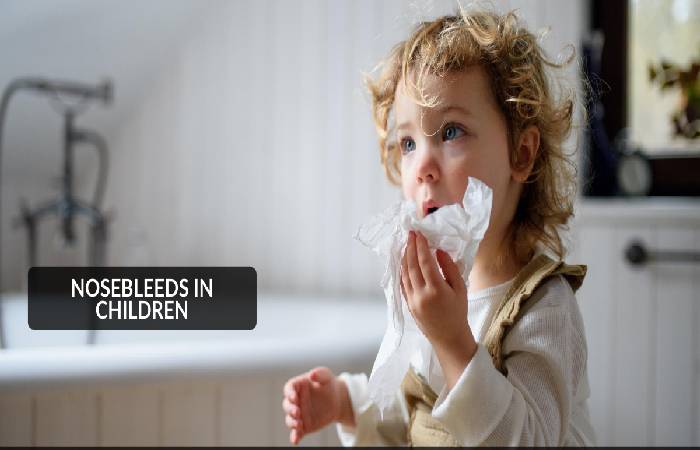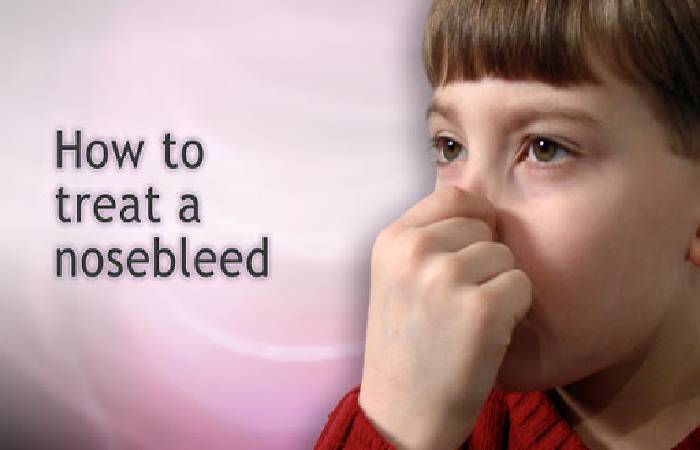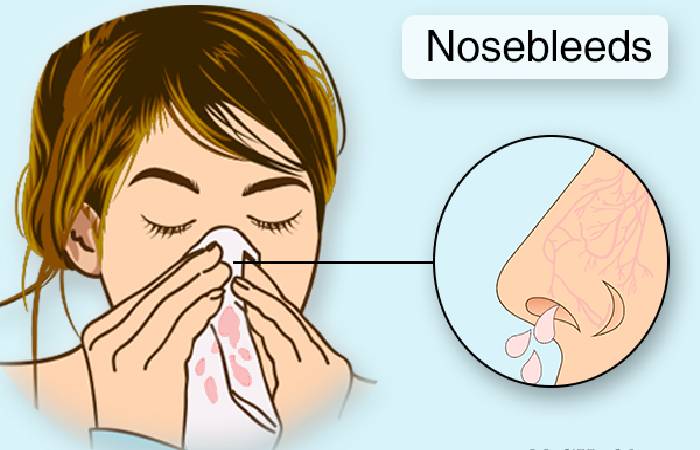Nosebleeds is not abnormal or dangerous, but it can scare us.
Most likely, your child’s nose will bleed at least once, and indeed many more times, during these early years. Some preschoolers bleed several times a week.
If blood flows from the back of the nose to the mouth and throat, however, your child will likely swallow quite a bit, which in turn can cause vomiting.
Table of Contents
What are the Causes of Nosebleeds?

There are many reasons why your nose bleeds, most of which are not severe. Starting with the most common, they include:
1. Colds and Allergies
- A cold or allergy causes inflammation and irritation inside the nose and also can cause spontaneous bleeding.
2. Trauma
- A child may get nosebleeds from sticking their fingers or another object inside the nose, or merely blowing too hard.
- There may also be bleeding if a ball or other object hits your nose, or if you fall and hit your nose.
3. Low Humidity or Irritating Fumes
- If your home is arid, or if you live in a dry climate, the lining of your child’s nose may dry out, and also making them more prone to bleeding.
- If you frequently expose to poisonous gases (fortunately not common), there may also be bleeding.
4. Anatomical Problems
- Any abnormal structure inside the nose can cause crusting and bleeding.
5. Abnormal Growths
- Any abnormal tissue that grows inside the nose can cause bleeding.
- Although most of these growths (usual polyps) are benign (not cancerous), they must treat as soon as possible.
6. Abnormal Blood Clotting
- Anything that interferes with blood clotting can cause nosebleeds.
- And also medications, even common ones like aspirin, can alter the clotting mechanism just enough to cause bleeding. Blood diseases, such as hemophilia, can also cause a nosebleed.
7. Chronic Illness
- Any child who has a long-term illness needs extra oxygen or other medication that can dry out.
- Affect the lining of the nose may have a nosebleed.
How to Treat Nosebleeds?

There are many popular misconceptions and beliefs about how to treat nosebleeds. There is a list of dos and don’ts.
Do’s
- Firstly keep calm. Nosebleeds can be scary but are rarely severe. Keep your child sitting or standing.
- Tilt your head slightly forward. If he is old enough, ask him to blow his nose gently.
- And also press down on the lower half of your child’s nose (the soft part) with your thumb and forefinger and hold it firmly for a full ten minutes.
- If your child is old enough, she can do it alone. Do not let go of your nose during this time to see if it is still bleeding.
- And also release the pressure after ten minutes and wait while your child is silent.
- If the bleeding has not stopped, repeat this step.
- The bleeding does not control an additional ten minutes of pressure, call your pediatrician, or go to the nearest emergency department.
Don’t
It will only scare your child. Ask him to lie down or tilt his head back.
Put tissues, gauze, or any other material inside the nose to stop the bleeding.
Also, call your pediatrician if:
- You think your son may have lost a lot of blood. (But remember that the blood coming out of the nose always seems to be a lot.)
- The bleeding is coming only from your child’s mouth, or he or she is coughing up or vomiting blood or brown material that looks like coffee grounds.
- And also your child is unusually pale or sweaty or is unresponsive. Call your pediatrician immediately in this case and take your child to the emergency room.
- He bleeds very frequently and also has chronic nasal congestion. It may mean that you have a small, easily ruptured blood vessel in the nose or lining of the nose, or a growth in the nasal passages.
- And also if a blood vessel causes the problem, the doctor may touch that spot with a chemical (silver nitrate) to stop the bleeding.
Prevention of Nosebleeds

If your child’s nose bleeds a lot, ask your pediatrician about using saltwater (saline) drops in the nose daily.
And also doing this can be particularly useful if you live in an arid climate, or when the oven is on.
Also, a humidifier or vaporizer will help keep the humidity in your home high enough to prevent your nose from drying out.
And also, tell your child not to put his fingers up his nose.
What are the Types of Nosebleeds?
Anterior Nosebleed
- The most common type of nosebleed is an anterior nosebleed, which affects the front of the nose.
- Capillaries, tiny blood vessels that line the nose inside, can break and bleed, causing this bleeding.
Posterior Nosebleed
- The posterior nosebleed occurs in the back or more in-depth part of the nose.
- In this type of bleeding, blood runs down the throat, even when sitting or standing.
- It is sporadic for children to have subsequent nosebleeds.
- They are more common in older people or high blood pressure (high blood pressure) or have injured their face or nose.
What are the Symptoms of Nosebleeds?
- Bleeding from inside the nose, with or without mucus;
- Vomit with blood;
- And also Black, Bloody, sticky stools (stools) like tar.
How do Care Your Children in Nosebleeds?
- Firstly stay calm and help your child do the same.
- Have the child sit up and lean forward slightly.
- Press firmly, continuously, on both sides (the soft nose parts) for 10 minutes. The child must breathe through the mouth.
- After 10 minutes, check to see if the bleeding stop. If the bleeding continues, press the sides of the nose again for ten more minutes.
- You may use an ice pack or pack on the bridge of your nose or sinuses.
- If the hematologist has prescribed any medicine, give it to the child.

